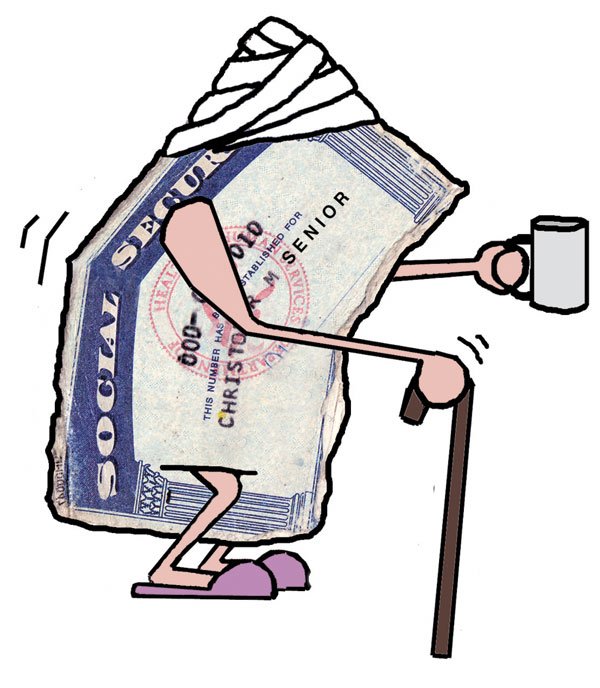Travis Thorson’s parents receive some Social Security, but he
doesn’t plan on getting any.
The 35-year-old tile contractor from Gilroy continues to put
money into his IRAs and the investment portfolio he’s established,
and has been planning on retirement by 50 or 55 since he started
his career.
Travis Thorson’s parents receive some Social Security, but he doesn’t plan on getting any.
The 35-year-old tile contractor from Gilroy continues to put money into his IRAs and the investment portfolio he’s established, and has been planning on retirement by 50 or 55 since he started his career.
That’s the best way to plan for retirement, said Mary Gibson, a certified financial planner in San Juan Bautista.
“What everybody should be doing for retirement is to plan on not getting into the thought that someone else is going to take care of them, but that they’re going to take care of themselves,” said Gibson. “Social Security itself was never meant to be a complete retirement plan. It’s a stop-gap measure.”
The thought may sound simple enough, but Gibson isn’t exactly preaching to the choir. Americans, by and large, believe the government should be mainly responsible for ensuring minimum standards of living for the elderly, according to a joint report issued by the Washington Post, Kaiser Family Foundation and Harvard University earlier this week.
Some 47 percent of Americans said that it was the government’s job to take care of the elderly, a figure equivalent to the combined number of people who responded that past employers, individuals or family members were the responsible parties.
Seventy percent of Americans think Social Security will go bankrupt in the next 30 years, although the number of people planning to rely on the program as their largest source of income – around 20 percent – has actually grown a few percentage points since 1997.
And despite President Bush’s recent comments on the crisis afflicting Social Security in his Feb. 2 State of the Union address, 22 percent of Americans – an increase of 8 percent since March 1997 – believe the program has only minor problems.
Aromas resident Randy Peyser, who said she’s “about to celebrate the 30th anniversary of my 20th birthday,” began taking classes in financial planning, real estate and credit as she became more and more concerned over the state of Social Security reforms.
“As a person who never really worried or thought about the future, now I’m working for that goal,” said Peyser, a freelance writer and book editor. Her current project is building enough capital to place a down payment on a home.
Like many people in her generation, Peyser isn’t ready to retire any time soon. She’s not prepared to do so financially, and she feels like she’s on the verge of the best years in her creative career.
“I think I’m doing what a lot of people are doing,” said Peyser. “I edited a regional and a national magazine, but now I write for magazines all over the country. What I see are more and more people leaving big business. They’ve been let down by too many corporations; too many lost pensions.”
Peyser’s thoughts are more or less in line with statistical data on potential retirees. The Kaiser Family Foundation report released in this week noted that the number of people looking toward an employer-paid pension plan had fallen dramatically, from 30 percent of Americans in 1997 to 14 percent today.
Part-time and consultation work are popular alternatives to retiring altogether, said John Bedell, a certified financial planner in Hollister and a registered principal with Sentra Securities for more than 19 years.
“I see people staying in their jobs, too, because the bigger concern than Social Security is qualifying for Medicare,” said Bedell. “It’s postponed retirements more than Social Security concerns. There are so many uncertainties in life today. Sometimes people, when they see they can afford retirement, will postpone it just to be on the safer side.”
The state of Social Security isn’t just a worry for those facing retirement now – young people must also plan for their own retirements.
“Many of us are going to be retired for potentially longer than we actually worked,” said Gibson. “In the past, you had a lot of workers for every retiree, maybe 16 or 17. Now you only have two or three, so the younger you can start, the more money you can save for yourself and your future.
Athena Driscoll, a 20-year-old who works part-time at Caffe Kaffe Vin in Morgan Hill and rents two rooms in a converted barn from her family, wonders if her generation has lost touch with the need to plan for a future.
“I’m just trying to get to having a life before I can think about saving for one,” she said. “You should start thinking about it when you feel like you’re mature enough to take care of yourself by yourself.
“Especially in America, it seems we’re so concerned with living in the now that we don’t really think about the future,” she added.
Young Americans in Driscoll’s position may want to become concerned, and quickly, since Social Security reforms of any kind will likely be balanced on their backs.
According to a fact page published by the Social Security Administration, by the time today’s 25-year-old reaches age 63, individual benefits will be cut by 27 percent and could be reduced each year thereafter.
“If you lived to be 100 years old in 2079 (which would be more common by then), your scheduled benefits could be reduced by 33 percent from today’s scheduled levels,” according to the fact page. “Social Security is not sustainable over the long term at present benefit and tax rates without large infusions of additional revenue. There will be a massive shortfall over the 75-year period.”
It may seem like a far-off problem for today’s young adults, but considering advancements in medical technology could produce significantly longer life spans, it’s something all future retirees will have to plan for.
“We tend to be a society that lives on credit debt,” said Gibson. “Dare to be different. Live within your means and save like crazy. If you can start putting money away in an IRA or a ROTH IRA at age 18 or 20, you’ll be way ahead of everyone else. If you’re a little further on, max out your 401K if you can. Max out your 403B, especially if there’s a contribution that your company makes because that’s free money.”
Just be realistic about savings goals, added Bedell. Not everyone needs to retire at 55.
“When you have kids in college or expenses during a period of time, you don’t want to beat yourself up because you can’t save during those periods,” said Bedell. “My philosophy is you do the best you can with what you have.”












